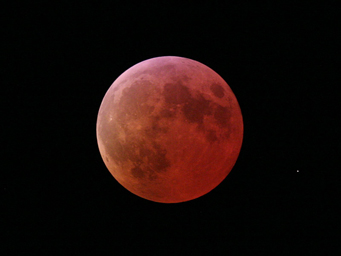
The March 3-4, 2007, total lunar eclipse was a relatively bright one. S&T editor Rick Fienberg captured this close-up of totality at 12:42 a.m. local time in Garching, Germany, where he was attending a planning meeting for the International Year of Astronomy 2009.
S&T: Rick Fienberg
Although much of Europe and North America were blanketed by clouds, a surprising number of people had unobstructed views of the March 3rd total lunar eclipse. Some 60 miles north of New York City, veteran eclipse watcher John Bortle experienced perfect conditions:
This break in the cloudy weather was timed perfectly. Five minutes after the partial phases had ended, the sky became overcast again!
Bortle noted that the eclipse was a relatively bright one, estimating it as magnitude -2.3 at mid-eclipse. Twenty-five miles south of him, noted astronomy writer and weatherman Joe Rao arrived at a nearly identical figure of -2.5. These estimates were derived by comparing the view of the Moon through reversed binoculars with Venus, Sirius, and Saturn. Both observers noted that all the major lunar features remained readily visible to the unaided eye throughout the eclipse.
Bortle rated the eclipse as a relatively colorless 3.5 on the Danjon scale, with the shadow's interior as "old rose" — a rather weak saturation of red. Rao perceived a more dramatic gradation of color, deepening to brick-red and finally brown or chocolate near the Moon's western edge. Rao gave the eclipse a Danjon rating of 2.8.
This eclipse was also notable for the occultation of the 5th-magnitude star 59 Leonis. Rao missed the star's reappearance, but he tracked it as the Moon moved away from it during the waning stages of the eclipse. He found it interesting that the star got harder to see as the Moon got brighter despite the increasing separation.
Observers in the Australia and the western half of North America, who missed most of this event, will have ringside seats for the next total lunar eclipse, on August 28th. Most people in the rest of the Americas and in eastern Asia will also be able to see some portion of totality.
 0
0
Comments
You must be logged in to post a comment.